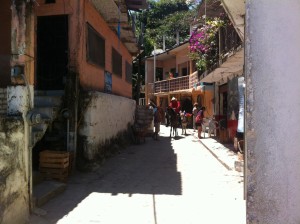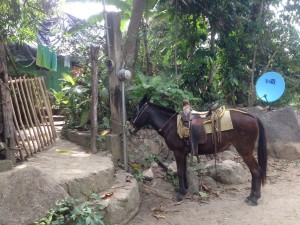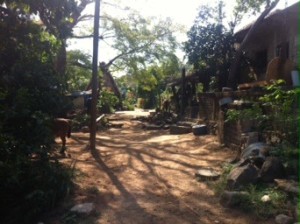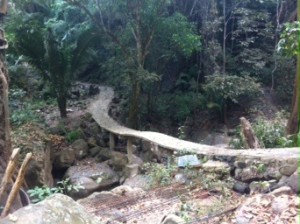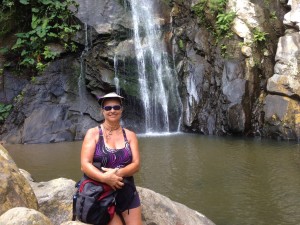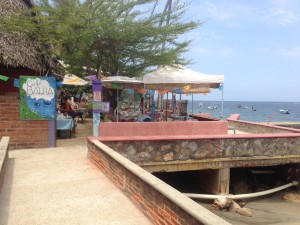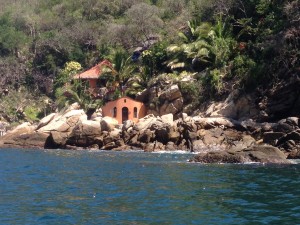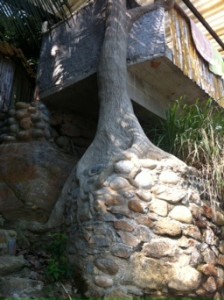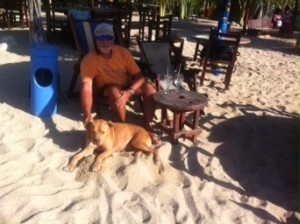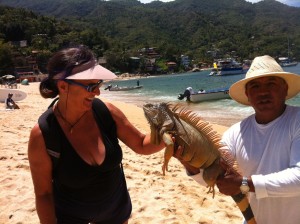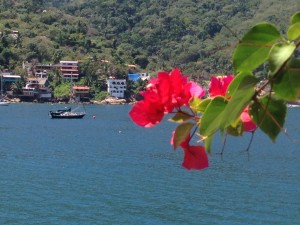So we left our beloved La Cruz de Huanacaxtle for five nights to be anchored in the gorgeous bay on the far end of Banderas Bay called Yelapa.
Yelapa is inaccessible by road; the only way to get there is by boat or by many many miles of trail through steep mountains. I was a bit apprehensive about seeing Yelapa again. I spent a few days there back in the early 80’s and remembered it as a place with virtually no hotels – there were a few rooms for rent through private homes and that was about it. There was no paved anything; dirt paths up steep hills were how you got everywhere, and wading through many river crossings if you headed up into the mountains. I had seen more recent pictures of Yelapa and it frightened me; apparently, electricity and telephone came to Yelapa in 2001, and ever since then, it has grown exponentially.
And indeed, yes, it was not the same place I knew 30 years ago; I hardly would have recognized it if it weren’t for the geography. There were several hotels on or overlooking the beach, although fortunately they were all small, privately owned hotels instead of corporately owned. And there were private homes tucked into the shoreline and hillside all the way around the bay. And all the paths in town had been paved with a combination of large river rock filled in by cement. Thirty years ago, the hike through town up to the closest of two waterfalls took about 45 minutes of climbing up a steep dirt path; the town now has extended all the way up to the waterfall and the path is paved, making it about a 10 minute easy walk.
Inspite of the progress made of the last 30 years, Yelapa stole my heart all over again. The stone paths weave up and down and around the town in such a way that there are no actual ‘corners,’ just where two or more paths meet, and no real path names as far as I could tell. Yes, there were some modern conveniences, but most people still get around on foot. Horses and donkeys are used to carry heavy loads. You can see the occasional quad-runner, usually transporting supplies or picking up garbage, but still no cars – the paved paths aren’t wide enough and the grades are too great! It was really an odd juxtaposition of centuries-old practices combined with modern technology, like the home pictured below: fallen timber bound together to make the walls, dirt floors, palm frond roof, horse tied up out in front to get to town, but plastic stretched over the roof to keep out leaks, and a television satellite dish!
Part of Yelapa’s charm is it’s incredibly rich geography. I can just imagine discovering this place for the first time as an indigenous tribe member centuries ago – a crescent-shaped protected bay teaming with all the fish you could possibly eat, surrounded by steep canyon walls creating a fresh breeze every day to fend off the heat, rich and abundant land thick with vegetation and overflowing with palm trees and ferns and jungle, and the mouths of two spring-fed fresh water rivers endlessly pouring their bounty into the sea. Fortunately when the Spanish first set foot here, they were so charmed by the peaceful indigenous community they found that they got the King of Spain to decree the land as independent of Spanish rule. The leaders of the Mexican Revolution also respected their autonomy, so Yelapa is part of an area considered to be something like a U.S. Indian reservation – they set their own laws, and no one can own property here that isn’t a descendent of the indigenous tribe that first settled here. Besides, it is isolated by steep terrain from the rest of Banderas Bay so no roads have been built to get here.
At some point, probably in the early 70’s, commercial passenger boats from Puerto Vallarta started bringing tourists to Yelapa for the day. A few palapa restaurants sprang up along the beach to service the tourists, and a few enterprising locals decided to guide tourists on donkeys up to the closest of the two waterfalls and back for a fee. They would all leave before nightfall, since there were no conveniences and no electricity, except for a select few who saw in Yelapa, their Shangra-la.
The first gringo settlers here in Yelapa starting mostly in the 70’s tended to be hippy-types, looking for the counter-culture experience of living off the land in an idyllic world with no electricity – a return to a simpler life, with natural foods, holistic medicine, and yoga. A woman I met back then named Patti from Oregon came as a tourist and met Valentino on the beach. Valentino was a member of the indigineous culture and therefore entitled to own property and make a living there. She gave up everything in the States to move down with him into a small hut with sand floors on the beach, which she diligently raked every day. She and Valentino still live in Yelapa, but now own several homes they rent out in addition to their nicely landscaped home in the jungle neighborhood behind the beach. Several other gringos have also refined their living situation over the decades of living in Yelapa, mostly by starting up restaurants that are now quite established, catering to the increasing number of tourists who spend whole vacations in Yelapa, and even many who have built homes along the cliffs. Interestingly, the majority of native English-speakers who were long-term residents of Yelapa that we met on this trip were women.
So, enough history. At first I wondered what Rick and I could do to keep ourselves busy for 5 days at Yelapa, but the next thing I knew, I realized we actually had to make up some kind of itinerary so we would squeeze everything in! There was the early morning hike to the distant waterfall, which took us about 2 1/2 hours one way. The path finally turned from paved stone to dirt, and we started stepping back in time again. I swear as we approached one settlement I felt like I was entering a path in Middle Earth and a hobbit with big feet would hop out of one of the huts at any moment.
The hike to the waterfall got steeper and steeper, and at one point we had to crawl through a wooden fence marked with an arrow above a hole marked, “waterfall/cascada.” No, maybe not Middle Earth, maybe I was Alice in Wonderland? It was really lovely to follow the path along and through the river all the way up to the waterfall, where we were greeted by a warm fresh pool of water to cool off in. We were the first on the trail that morning but were soon joined by a few other families, one from Canada and one Mexican. On our way back we stopped at a little cafe, sort of, alongside the river, run by a woman named Christina. She is a North American ex-patriot, the sole proprietor, and is only open Monday, Wednesday and Friday. She lives alone in this jungle location well out of town, her bed is in her kitchen and you have to walk through the kitchen to climb down the stone stairs and over a tree trunk to get to the cafe seating area alongside the river. The cafe chairs were carved out of palm tree trunks. When your food is ready, you have to climb back up the stairs to get it. She is an ex-emergency room nurse who moved down to Yelapa decades ago, and specializes in vegan, gluten-free, and non-GMO dishes. She actually made a great black bean soup and beet salad. She was a bit of an odd character, but what would you expect from someone who had been living alone in the jungle for decades?
Another one of my interests was to spend some time in Yelapa in the evening, so one night we went to movie night at an outdoor restaurant across the river from the beach where our dinghy was resting. The high tide increases the river depth and width considerably, and the locals understated by just how much it would rise that night, so we found ourselves practically swimming back across the river. A little uncertain of what I might find in a jungle river that I couldn’t see, I asked a local about the safety of crossing at high water at night and she said there was absolutely nothing to worry about. Yeah right. But I took her word for it and we were fortunate to have nothing attack us but swarms of tadpoles.
Another night we were able to get into a restaurant we had been lusting after ever since we spotted it from the steep stone path above the town. It was called Los Abuelos (the grandparents), Mexican-family-owned, and it was some of the best food we have had in Mexico at the least expensive prices. We also went to the ‘Yelapa Yacht Club,’ which isn’t a yacht club at all, it just named itself that, but it was fun – overlooking the town beach, open only at night, they have a large dance floor and good music, sometimes live. We got a few salsa dances in and then decided to head back to the boat. This time I had persuaded Rick to land the dinghy on the town beach near the restaurant so we didn’t have to face another river crossing in the dark!
Just for old-times sake, I wanted to see the waterfall that was the closest to town again, just to see how much the path had changed. We hiked up there early one morning before the tourists started arriving on donkey, and were a bit under-impressed. It was much more romantic when it was a remote destination rather at the end of a paved path on the edge of town, with cement walls surrounding a part of it.
After that we roamed town a bit and had a tasty North American breakfast overlooking the town beach at a restaurant called Bahia. Again, this restaurant was run by a North American woman, probably in her 50’s, who had been in Yelapa for a long time.
Another day we set about hiking the edge of the bay from one side to another. It is unbelievable how many homes and boutique hotels have been tucked into the hillside, all with unique architecture designed to blend into the environment. Many appear to be available for short-term rentals. The path gets narrow at parts but it do-able for able bodies although I am not sure how those houses get supplies delivered to them! We took some pictures of some of them to research as possible places to rent when our kids come visit next December.
And of course, we took at least one day to just sog on the tourist beach, eat at a restaurant there, sit in lounge chairs under an umbrella and sip margaritas at the end of the day. Rick befriends dogs everywhere we go, and apparently I look like someone who would pay to pet an iguana.
The anchorage itself is dotted with moorings because the bay is too deep for most anchoring Riggs, so we took advantage of the moorings to rent one for ourselves. Our first night mooring was located at the west side of the bay and was too rolly, but for the next four nights, we moved to another more comfortable location. The only problem we had was when leaving, we couldn’t get our mooring line unfastened from the mooring because it had become hopelessly wrapped after multiple tide changes. And of course, the young man who had rented us the mooring was nowhere to be found. Fortunately, we found another guy in a panga who was willing to struggle with it until he got it loose.
Thinking we had successfully dodged the heaviest tourist season of the year in the more crowded Puerto Vallarta area (Semana Santa-Easter week), we headed over to Paradise Village Marina in Nuevo Vallarta on Monday.


